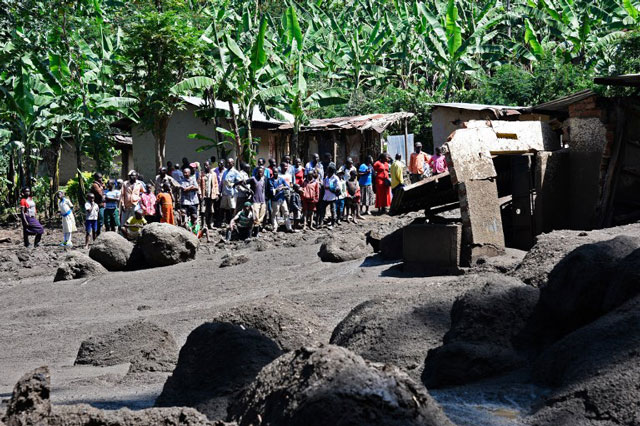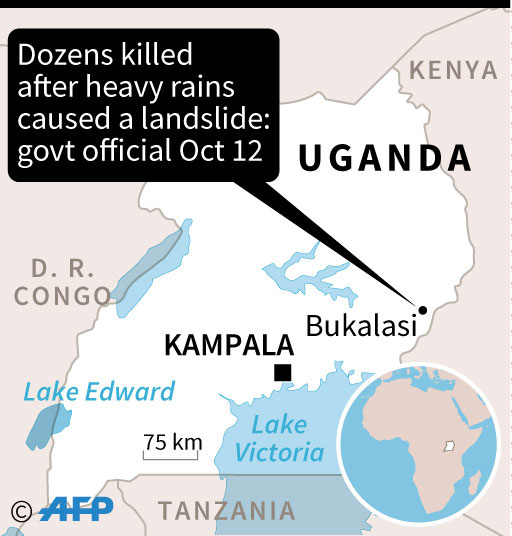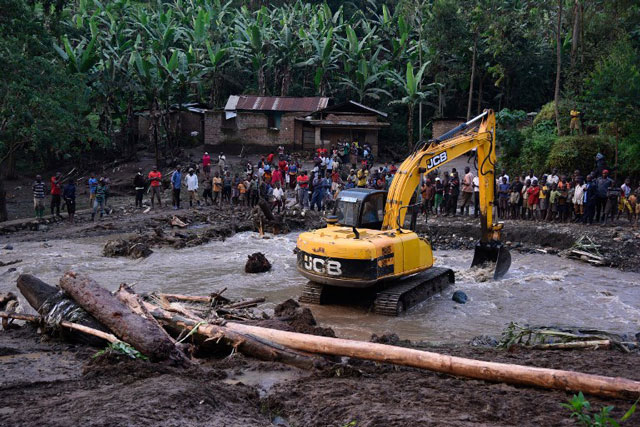
Bududa, Uganda | AFP – Michael O’HAGAN | On a muddy outcrop on the banks of the Sume river, grief-stricken families gaze at enormous boulders that stand testimony to the force of the deluge which engulfed their homes.
Hundreds of newly-deposited rocks, each the size of a van, litter the riverbanks after Thursday’s landslide which killed 42 people and swept away nearly 150 homes.
At one spur just below Wanjenwa village, two colossal boulders match the size of the houses they smashed as the torrent propelled them down the mountain, crushing everything in their path.
Evelyn Wantsema was at home in the riverbank village of Nyehe with her two boys, Muhammad, 4, and Joseph, 2, when she heard unsettling noise approaching.
“I looked out and saw this catastrophe coming with a lot of rocks and trees,” she said.
“There was no time. I ran with Joseph and had to leave Muhammad,” sobbed this young mother of 20.
“I thought I’d lost him.”
As soon as the worst of the waters subsided, Wantsema rushed back to her home and found Muhammad buried in mud.
“I saw one of his hands, grabbed it and pulled him out alive.”

– ‘So fast’ –
Thursday was market day in Wanjenwa and although it had been raining for a couple of days, witnesses said it was not unusually heavy and people were walking around meeting friends.
“Until this week, the Sume was like a stream — even children could play in it,” said Amos Wabianga a 45-year-old farmer.
“The first sign something was wrong was soil in the water which made it dark,” said Michael Namutambo, a primary school teacher.
“People didn’t think it was a problem and didn’t run. Then what followed was the real calamity — rocks, timber. People couldn’t manage the speed of the mudslide — it was so fast,” the 33-year-old said.
“Whoever took this direction survived somehow,” he said gesturing to the right. “Those who took the other direction died”
The official death toll stands at 42 with 858 people displaced and an unknown number missing.
– Improved monitoring –
The government agency in charge of relief said a landslide in the forest high above the villages blocked the Sume river causing it to burst its banks and sending a cascade of huge rocks tumbling down the hillside.
“The Bukalasi landslide-triggered disaster is the 67th registered between May and October this year,” said a statement by Martin Owor, commissioner for disaster preparedness.
He said there had been 67 landslides this year, but only this one had resulted in deaths whereas in previous years, every landslide had caused fatalities, attributing the improved preparedness to a community-based Landslide Risk Monitoring System.
But Godfrey Mujuni a government meteorologist told AFP there was no early warning system in the area, with local people confirming that other than the standard seasonal advice, they did not receive any additional warnings.
The government says families at risk of landslides across the country will be resettled elsewhere but villagers say the land offered them is unsuitable and promises remain unfulfilled.

– ‘Where should we go?’ –
Nathan Tumuhamye, director of an organisation which helps communities recover from natural disasters and conflict, told AFP that although several households had been resettled under a government programme, the scheme had largely failed.
“People were being moved from mountainous land which is so fertile you could just throw a seed in the soil and it will grow, to areas which are extremely flat and where the conditions for farming are extremely different.”
Those living in vulnerable areas were hesitant to leave their ancestral homes and “felt a great psychological attachment to the mountains,” he said.
In March 2010, at least 100 people were killed in the same mountainous region, which lies on the border between Uganda and Kenya and is a high-risk area for landslides.
Namutambo, the school teacher, was also caught up in that disaster and recalled how government officials turned up to register people for resettlement but took no further action.
“They came and took our photos but then disappeared and never came back,” he told AFP.
“The place they told us to go in 2010 is land that floods and no one can farm,” he said.
“We have always been warned we should move but the question is, where do we go?”
 The Independent Uganda: You get the Truth we Pay the Price
The Independent Uganda: You get the Truth we Pay the Price



